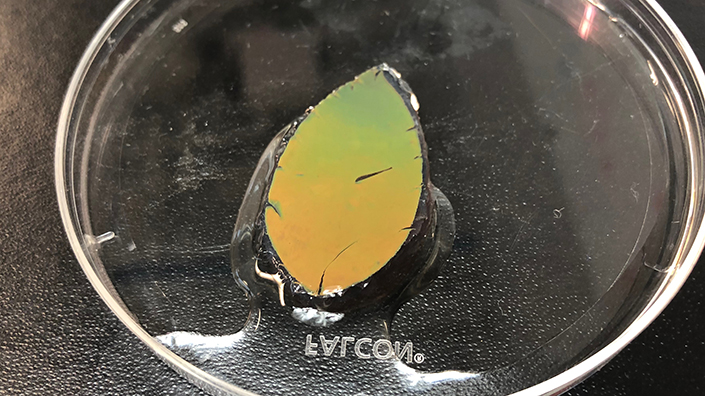Engineering news
Researcher Yixiao Dong from Emory University in Georgia state was watching videos of the lizards when he was struck by a potential solution to a major problem with colour-changing skins.
Chameleons can alter the colour of their skin to either blend into the background to hide, or stand out to defend their territory and attract mates. They make this trick look easy, using particles known as photonic crystals in their skin. Researchers, however, have struggled to make a photonic crystal ‘smart skin’ that changes colour in response to the environment without also changing in size – and “no-one wants a camouflage cloak that shrinks to change colour,” said senior author Khalid Salaita from Emory.
Colouration in adaptive organisms, also including the neon tetra fish, is not based on pigments but on photonic crystals in a repeating pattern. The intervals between these particles causes the material to interfere with wavelengths of light, allowing some through while rejecting others.
To mimic chameleons and create an artificial smart skin, scientists previously experimented with embedding photonic crystal ‘arrays’ into flexible hydrogels. Expanding or contracting the hydrogel changed the spacing between arrays, resulting in a colour change. The accordion-like action also caused the hydrogel to significantly grow or shrink however, leading to structural instability and buckling of the material.
Watching close-up time-lapsed images of chameleons changing hues, Dong noticed the animals’ photonic crystals arrays did not cover the entire skin but were spread out within a ‘dark matrix’. As they appeared to change colour, the patches of colour remained the same distance apart. The first author hypothesised that the skin cells making up the dark matrix somehow adjusted to compensate for the shifts in the photonic crystals.
To mimic the technique, the researchers used magnets to arrange patterns of photonic crystals containing iron oxide within a hydrogel. They then embedded these arrays into a second, non-colour-changing hydrogel. The second, springy hydrogel was mechanically matched to the first hydrogel, compensating for shifts in distances between the photonic crystals.
When heated, the creation – known as strain-accommodating smart skin (Sass) – changed colour but maintained a near-constant size. Chemist Dong also tested the material in sunlight. Fish- and leaf-shaped Sass films shifted from orange to green over 10 minutes, without changing in size.

The leaf-shaped sample changes from yellow-orange to green (Credit: Emory University)
"We've provided a general framework to guide the future design of artificial smart skins," Dong says. "There is still a long way to go for real-life applications, but it's exciting to push the field another step further."
The paper, which also involved researchers from Georgia Tech, was published in ACS Nano.
Want the best engineering stories delivered straight to your inbox? The Professional Engineering newsletter gives you vital updates on the most cutting-edge engineering and exciting new job opportunities. To sign up, click here.